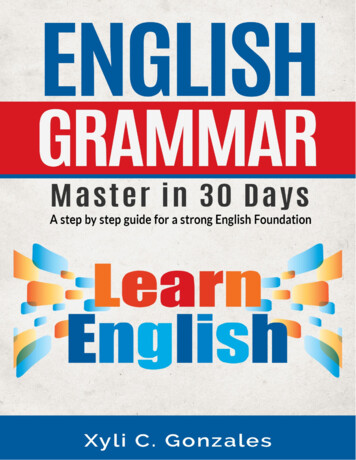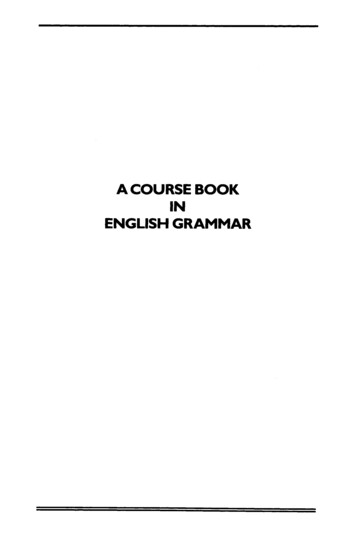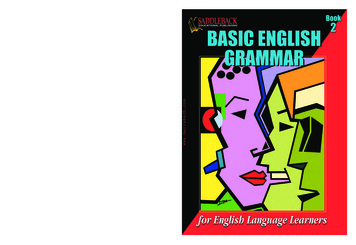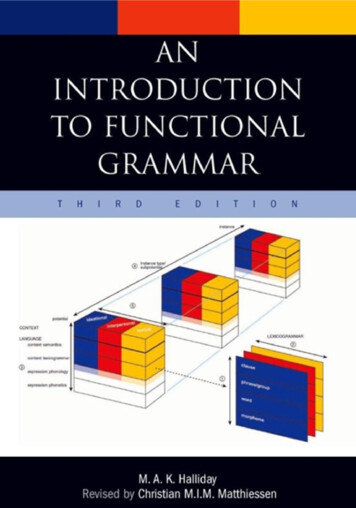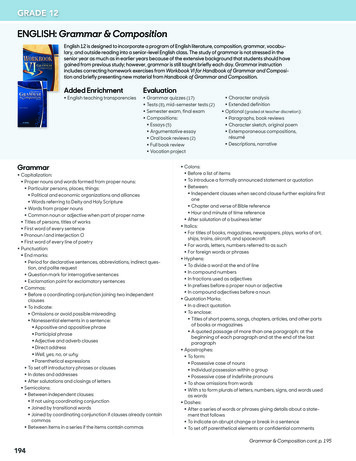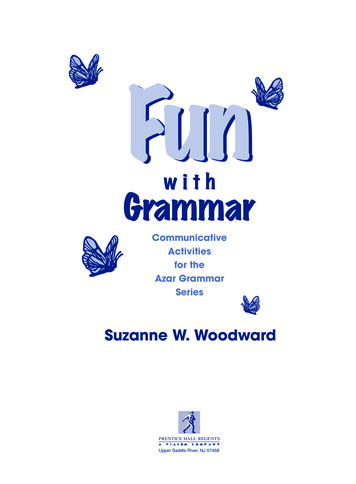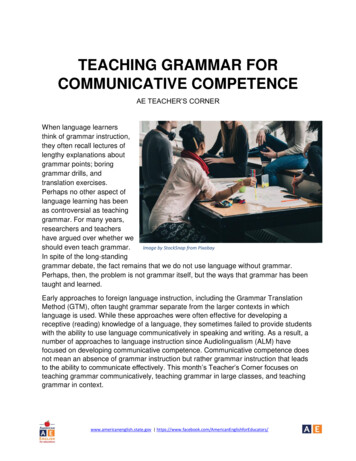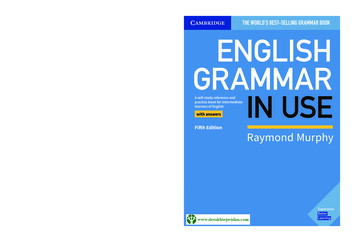
Transcription
THE WORLD’S BEST-SELLING GRAMMAR BOOKENGLISHGRAMMARIN USEA self-study reference andpractice book for intermediatelearners of Englishwith answersFifth Edition xplanations,audio and prs of English.Poom ess,cat’.orks,including individualonation.e English,s.REDMAN978-0-521-14989-1ENGLISH VOCABULARY IN USE Pre-intermediate &intermediate (with answers) &CD-ROMCMYKode and instructions inside.Be teLearninis our sim le ap roach wheredeeper insights help shape richer content thatdrives stronger esults.Discover more:cambricambriCC MM YY KKC M Y Kis our sim le ap roach whereDiscover more: e.o /be e lea nin e.o /be e lea nin Hewings: Advanced Grammar in Use With answers & ebook 3rd Edition CoverLearnindrives stronger esults.978-0-521-14989-1with simple ‘listactivities,modelled with a clesounds,wBe tedeeper insights help shape richer content that97811075393039781107539303 Hewings:Hewings: AdvancedAdvanced GrammarGrammar inin UseUse WithWith answersanswers && ebookebook 3rd3rd EditionEdition CoverCover9781107539303 More than 35,000 definitions and hundreds of new words Definitions are written in clear, simple English Thesaurus boxes help you to expand your vocabulary Common Learner Error boxes, based on learner errors from the Cambridge Over 1,000 Word Partner boxes show the important collocations that willCD-ROM SMART thesaurus – a dictionary and a thesaurus in one! Spoken British and American pronunciation for every word ‘Record yourself’ feature helps you with pronunciation practiceREDMAN ENGLISH VOCABULARY IN USE Pre-intermediate &intermediate (with answers) &CD-ROM CMYKM Y KM Y K 9781107539303 Hewings: Advanced Grammar in Use With answers & ebook 3rd Edition Cover C 978 1 316 63174 4 Redman: English Vocabulary in Use pre-int and int Cover C9781107539303 Hewings: Advanced Grammar in Use With answers & ebook 3rd Edition Cover CM Y K Be teLearninis our sim le ap roach wheredeeper insights help shape richer content thatdrives stronger esults.Discover more:cambriBe teLearnine.o /be e lea ninis our sim le ap roach whereinsights shape content that drives esults.Discover more:cambrie.o /be e lea ninRaymond Murphy
ENGLISHGRAMMARIN USEA self-study reference andpractice book for intermediatelearners of Englishwith answersFifth EditionRaymond Murphy
University Printing House, Cambridge CB2 8BS, United KingdomOne Liberty Plaza, 20th Floor, New York, NY 10006, USA477 Williamstown Road, Port Melbourne, VIC 3207, Australia314–321, 3rd Floor, Plot 3, Splendor Forum, Jasola District Centre, New Delhi – 110025, India79 Anson Road, #06-04/06, Singapore 079906Cambridge University Press is part of the University of Cambridge.It furthers the University’s mission by disseminating knowledge in the pursuit ofeducation, learning and research at the highest international levels of excellence.www.cambridge.orgInformation on this title: www.cambridge.org/9781108457651 Cambridge University Press 1985, 1994, 2004, 2012, 2019This publication is in copyright. Subject to statutory exceptionand to the provisions of relevant collective licensing agreements,no reproduction of any part may take place without the writtenpermission of Cambridge University Press.First published 1985Second edition 1994Third edition 2004Fourth edition 2012Fifth edition 201920 19 18 17 16 15 14 13 12 11 10 9 8 7 6 5 4 3 2Printed in Malaysia by Vivar PrintingA catalogue record for this publication is available from the British -108-45773-6Student’s Book with answersStudent’s Book with answers and ebookStudent’s Book without answersInteractive ebookSupplementary ExercisesCambridge University Press has no responsibility for the persistence or accuracyof URLs for external or third-party internet websites referred to in this publication,and does not guarantee that any content on such websites is, or will remain,accurate or appropriate. Information regarding prices, travel timetables, and otherfactual information given in this work is correct at the time of first printing butCambridge University Press does not guarantee the accuracy of such informationthereafter.
ContentsThanks viiTo the student viiiTo the teacher xPresent and past1 Present continuous (I am doing)2 Present simple (I do)3 Present continuous and present simple 1 (I am doing and I do)4 Present continuous and present simple 2 (I am doing and I do)5 Past simple (I did)6 Past continuous (I was doing)Present perfect and past7 Present perfect 1 (I have done)8 Present perfect 2 (I have done)9 Present perfect continuous (I have been doing)10 Present perfect continuous and simple (I have been doing and I have done)11 how long have you (been) ?12 for and since when ? and how long ?13 Present perfect and past 1 (I have done and I did)14 Present perfect and past 2 (I have done and I did)15 Past perfect (I had done)16 Past perfect continuous (I had been doing)17 have and have got18 used to (do)Future19 Present tenses (I am doing / I do) for the future20 I’m going to (do)21 will and shall 122 will and shall 223 I will and I’m going to24 will be doing and will have done25 when I do and when I’ve done if and whenModals26 can, could and (be) able to27 could (do) and could have (done)28 must and can’t29 may and might 130 may and might 231 have to and must32 must mustn’t needn’t33 should 134 should 235 I’d better it’s time 36 would37 can/could/would you ? etc. (Requests, offers, permission and invitations)IF YOU ARE NOT SURE WHICH UNITS YOU NEED TO STUDY, USE THE STUDY GUIDE ON PAGE 326.iii
if and wish38 if I do and if I did 39 if I knew I wish I knew 40 if I had known I wish I had known 41 wishPassive42 Passive 1 (is done / was done)43 Passive 2 (be done / been done / being done)44 Passive 345 it is said that he is said to he is supposed to 46 have something doneReported speech47 Reported speech 1 (he said that )48 Reported speech 2Questions and auxiliary verbs49 Questions 150 Questions 2 (do you know where ? / he asked me where )51 Auxiliary verbs (have/do/can etc.) I think so / I hope so etc.52 Question tags (do you? isn’t it? etc.)-ing and to 53 Verb -ing (enjoy doing / stop doing etc.)54 Verb to (decide to / forget to etc.)55 Verb ( object) to (I want you to )56 Verb -ing or to 1 (remember, regret etc.)57 Verb -ing or to 2 (try, need, help)58 Verb -ing or to 3 (like / would like etc.)59 prefer and would rather60 Preposition (in/for/about etc.) -ing61 be/get used to (I’m used to )62 Verb preposition -ing (succeed in -ing / insist on -ing etc.)63 there’s no point in -ing, it’s worth -ing etc.64 to , for and so that 65 Adjective to 66 to (afraid to do) and preposition -ing (afraid of -ing)67 see somebody do and see somebody doing68 -ing clauses (He hurt his knee playing football.)Articles and nouns69 Countable and uncountable 170 Countable and uncountable 271 Countable nouns with a/an and some72 a/an and the73 the 174 the 2 (school / the school etc.)75 the 3 (children / the children)76 the 4 (the giraffe / the telephone / the old etc.)77 Names with and without the 1ivIF YOU ARE NOT SURE WHICH UNITS YOU NEED TO STUDY, USE THE STUDY GUIDE ON PAGE 326.
78798081Names with and without the 2Singular and pluralNoun noun (a bus driver / a headache)-’s (your sister’s name) and of (the name of the book)Pronouns and determiners82 myself/yourself/themselves etc.83 a friend of mine my own house on my own / by myself84 there and it 85 some and any86 no/none/any nothing/nobody etc.87 much, many, little, few, a lot, plenty88 all / all of most / most of no / none of etc.89 both / both of neither / neither of either / either of90 all every whole91 each and everyRelative clauses92 Relative clauses 1: clauses with who/that/which93 Relative clauses 2: clauses with and without who/that/which94 Relative clauses 3: whose/whom/where95 Relative clauses 4: extra information clauses (1)96 Relative clauses 5: extra information clauses (2)97 -ing and -ed clauses (the woman talking to Tom, the boy injured in the accident)Adjectives and adverbs98 Adjectives ending in -ing and -ed (boring/bored etc.)99 Adjectives: a nice new house, you look tired100 Adjectives and adverbs 1 (quick/quickly)101 Adjectives and adverbs 2 (well, fast, late, hard/hardly)102 so and such103 enough and too104 quite, pretty, rather and fairly105 Comparative 1 (cheaper, more expensive etc.)106 Comparative 2 (much better / any better etc.)107 Comparative 3 (as as / than)108 Superlative (the longest, the most enjoyable etc.)109 Word order 1: verb object; place and time110 Word order 2: adverbs with the verb111 still any more yet already112 evenConjunctions and prepositions113 although though even though114 in case115 unless as long as provided116 as (as I walked / as I was etc.)117 like and as118 like as if119 during for while120 by and until by the time in spite ofdespiteIF YOU ARE NOT SURE WHICH UNITS YOU NEED TO STUDY, USE THE STUDY GUIDE ON PAGE 326.v
Prepositions121 at/on/in (time)122 on time and in time at the end and in the end123 in/at/on (position) 1124 in/at/on (position) 2125 in/at/on (position) 3126 to, at, in and into127 in/on/at (other uses)128 by129 Noun preposition (reason for, cause of etc.)130 Adjective preposition 1131 Adjective preposition 2132 Verb preposition 1 to and at133 Verb preposition 2 about/for/of/after134 Verb preposition 3 about and of135 Verb preposition 4 of/for/from/on136 Verb preposition 5 in/into/with/to/onPhrasal verbs137 Phrasal verbs 1138 Phrasal verbs 2139 Phrasal verbs 3140 Phrasal verbs 4141 Phrasal verbs 5142 Phrasal verbs 6143 Phrasal verbs 7144 Phrasal verbs 8145 Phrasal verbs 9Appendix 1Appendix 2Appendix 3Appendix 4Appendix 5Appendix 6Appendix 7Introductionin/outouton/off (1)on/off (2)up/downup (1)up (2)away/backRegular and irregular verbs 292Present and past tenses 294The future 295Modal verbs (can/could/will/would etc.) 296Short forms (I’m / you’ve / didn’t etc.) 297Spelling 298American English 300Additional exercises302Study guide 326Key to Exercises 336Key to Additional exercisesKey to Study guide 372368Index 373viIF YOU ARE NOT SURE WHICH UNITS YOU NEED TO STUDY, USE THE STUDY GUIDE ON PAGE 326.
ThanksThis is the fifth edition of English Grammar in Use. I wrote the original edition when I was a teacher at theSwan School of English, Oxford. I would like to repeat my thanks to my former colleagues and students atthe school for their help, encouragement and interest at that time.Regarding the production of this fifth edition, I would like to thank Rebecca Winthrop and Chris Capper.Design & IllustrationsQ2A Media Services Pvt. Ltd.vii
To the studentThis book is for students who want help with English grammar. It is written for you to use withouta teacher.The book will be useful for you if you are not sure of the answers to questions like these:What is the difference between I did and I have done?When do we use will for the future?What is the structure after I wish?When do we say used to do and when do we say used to doing?When do we use the?What is the difference between like and as?These and many other points of English grammar are explained in the book, and there are exerciseson each point.LevelThe book is intended mainly for intermediate students (students who have already studied the basicgrammar of English). It concentrates on those structures that intermediate students want to use, butthat often cause difficulty. Some advanced students who have problems with grammar will also findthe book useful.The book is not suitable for elementary learners.How the book is organisedThere are 145 units in the book. Each unit concentrates on a particular point of grammar. Someproblems (for example, the present perfect or the use of the) are covered in more than one unit. For alist of units, see the Contents at the beginning of the book.Each unit consists of two facing pages. On the left there are explanations and examples; on the rightthere are exercises. At the back of the book there is an Answer Key for you to check your answers tothe exercises (page 336).There are also seven Appendices at the back of the book (pages 292–301). These include irregularverbs, summaries of verb forms, spelling, and American English.Finally, there is a detailed Index at the back of the book (page 373).How to use the bookThe units are not in order of difficulty, so it is not intended that you work through the book frombeginning to end. Every learner has different problems, and you should use this book to help youwith the grammar that you find difficult.It is suggested that you work in this way:Use the Contents and/or Index to find which unit deals with the point you are interested in.If you are not sure which units you need to study, use the Study guide on page 326.Study the explanations and examples on the left-hand page of the unit you have chosen.Do the exercises on the right-hand page.Check your answers with the Key.If your answers are not correct, study the left-hand page again to see what went wrong.You can, of course, use the book simply as a reference book without doing the exercises.viii
Additional exercisesAt the back of the book there are Additional exercises (pages 302–325). These exercises bring togethersome of the grammar points from a number of different units. For example, Exercise 16 brings togethergrammar points from Units 26–36. You can use these exercises for extra practice after you have studiedand practised the grammar in the units concerned.ebookAn ebook version of English Grammar in Use is also available to buy.ix
To the teacherEnglish Grammar in Use was written as a self-study grammar book, but teachers may also find ituseful as additional course material in cases where further work on grammar is necessary.The book will probably be most useful at middle- and upper-intermediate levels (where all ornearly all of the material will be relevant), and can serve both as a basis for revision and as a meansfor practising new structures. It will also be useful for some more advanced students who haveproblems with grammar and need a book for reference and practice. The book is not intended to beused by elementary learners.The units are organised in grammatical categories (Present and past, Articles and nouns, Prepositionsetc.). They are not ordered according to level of difficulty, so the book should not be worked throughfrom beginning to end. It should be used selectively and flexibly in accordance with the grammarsyllabus being used and the difficulties students are having.The book can be used for immediate consolidation or for later revision or remedial work. It mightbe used by the whole class or by individual students needing extra help. The left-hand pages(explanations and examples) are written for the student to use individually, but they may of coursebe used by the teacher as a source of ideas and information on which to base a lesson. The studentthen has the left-hand page as a record of what has been taught and can refer to it in the future.The exercises can be done individually, in class or as homework. Alternatively (and additionally),individual students can be directed to study certain units of the book by themselves if they haveparticular difficulties not shared by other students in their class. Don’t forget the Additional exercisesat the back of the book (see To the student).English Grammar in Use Fifth EditionThis is a new edition of English Grammar in Use. The differences between this edition and the fourthedition are:Much of the material has been revised or reorganised, and in most units there are changes in theexamples, explanations and exercises.The book has been redesigned with new, updated illustrations.There is a new ebook available with all the contents of the book as well as audio, access to adictionary and more.An edition of English Grammar in Use without the Key is also available. Some teachers may preferto use this with their students.x
ENGLISHGRAMMARIN USE
UnitPresent continuous (I am doing)1AStudy this example situation:Sarah is in her car. She is on her way to work.She’s driving to work. ( She is driving )This means: she is driving now, at the time of speaking.The action is not finished.am/is/are -ing is the present continuous:Ihe/she/itwe/you/theyBamisare( I’m)( he’s etc.)( we’re etc.)drivingworkingdoing etc.I am doing something I started doing it and I haven’t finished; I’m in the middle of doing it.Please don’t make so much noise. I’m trying to work. (not I try)‘Where’s Mark?’ ‘He’s having a shower.’ (not He has a shower)Let’s go out now. It isn’t raining any more. (not It doesn’t rain)How’s your new job? Are you enjoying it?What’s all that noise? What’s going on? or What’s happening?Sometimes the action is not happening at the time of speaking. For example:Steve is talking to a friend on the phone. He says:I’m reading a really good book at the moment.It’s about a man who Steve says ‘I’m reading ’ but he is not reading the book atthe time of speaking.He means that he has started reading the book, but has notfinished it yet. He is in the middle of reading it.Some more examples:Kate wants to work in Italy, so she’s learning Italian.(but perhaps she isn’t learning Italian at the time of speaking)Some friends of mine are building their own house. They hope to finish it next summer.CYou can use the present continuous with today / this week / this year etc. (periods around now):a: You’re working hard today. (not You work hard today)b: Yes, I have a lot to do.The company I work for isn’t doing so well this year.DWe use the present continuous when we talk about a change that has started to happen. We often usethese verbs in this way:getting, becomingstarting, beginningchanging, improvingincreasing, rising, falling, growingIs your English getting better? (not Does your English get better)The population of the world is increasing very fast. (not increases)At first I didn’t like my job, but I’m starting to enjoy it now. (not I start)2Present continuous and present simple Units 3–4Present tenses for the future Unit 19
UnitExercises1.11What’s happening in the pictures? Choose from these verbs:cross1hidescratch21 She’s taking2 He31.21.4tiewave34a picture.a shoelace.the road.56456his head.behind a tree.to somebody.The sentences on the right follow those on the left. Which sentence goes with which?123456781.3takePlease don’t make so much noise.We need to leave soon.I don’t have anywhere to live right now.I need to eat something soon.They don’t need their car any more.Things are not so good at work.It isn’t true what they say.We’re going to get wet.Write questions. Use the present continuous.1 What’s all that noise? What’s happening?2 What’s the matter?3 Where’s your mother?4 I haven’t seen you for ages.5 Amy is a student.6 Who are those people?7 I heard you started a new job.8 We’re not in a hurry.abcdefghI’m getting hungry.They’re lying.It’s starting to rain.They’re trying to sell it.It’s getting late.I’m trying to work.I’m staying with friends.The company is losing money.12345678f(what / happen?)(why / you / cry?)(she / work / today?)(what / you / do / these days?)(what / she / study?)(what / they / do?)(you / enjoy / it?)(why / you / walk / so fast?)Put the verb into the correct form, positive (I’m doing etc.) or negative (I’m not doing etc.).1 Please don’t make so much noise. I’m trying (I / try) to work.2 Let’s go out now. It isn’t raining (it / rain) any more.3 You can turn off the radio.(I / listen) to it.4 Kate phoned last night. She’s on holiday with friends.(She / have)a great time and doesn’t want to come back.5 Andrew started evening classes recently.(He / learn) Japanese.6 Paul and Sarah have had an argument and now(they / speak)to one another.7 The situation is already very bad and now(it / get) worse.8 Tim(work) today. He’s taken the day off.9(I / look) for Sophie. Do you know where she is?10 The washing machine has been repaired.(It / work) now.11(They / build) a new hospital. It will be finished next year.12 Ben is a student, but he’s not very happy.(He / enjoy) his course.13(The weather / change). Look at those clouds.I think it’s going to rain.14 Dan has been in the same job for a long time.(He / start) to get boredwith it.3
UnitPresent simple (I do)2AStudy this example situation:Alex is a bus driver, but now he is in bed asleep.He is not driving a bus. (He is asleep.)but He drives a bus. He is a bus driver.drive(s), work(s), do(es) etc. is the present simple:I/we/you/theyhe/she/itBdrive/work/do etc.drives/works/does etc.We use the present simple to talk about things in general. We use it to say that something happens all thetime or repeatedly, or that something is true in general:Nurses look after patients in hospitals.I usually go away at weekends.The earth goes round the sun.The cafe opens at 7.30 in the morning.We say:I workthey teachbutbuthe worksmy sister teachesyou goI havebutbutit goeshe hasFor spelling (-s or -es), see Appendix 6.CWe use do/does to make questions and negative oI come from Canada. Where do you come from?I don’t go away very often.What does this word mean? (not What means this word?)Rice doesn’t grow in cold climates.In the following examples, do is also the main verb (do you do / doesn’t do etc.):‘What do you do?’ ‘I work in a shop.’He’s always so lazy. He doesn’t do anything to help.DWe use the present simple to say how often we do things:I get up at 8 o’clock every morning.How often do you go to the dentist?Julie doesn’t drink tea very often.Robert usually goes away two or three times a year.EI promise / I apologise etc.Sometimes we do things by saying something. For example, when you promise to do something,you can say ‘I promise ’; when you suggest something, you can say ‘I suggest ’:I promise I won’t be late. (not I’m promising)‘What do you suggest I do?’ ‘I suggest that you ’In the same way we say: I apologise / I advise / I insist / I agree / I refuse etc.4Present simple and present continuous Units 3–4Present tenses for the future Unit 19
UnitExercises2.12Complete the sentences using the following verbs:cause(s)close(s)1 Tanya speaks2 Ben and Jackschool.3 Bad driving4 The s)5 My parentsin a very smallflat.6 The Olympic Gamesplaceevery four years.7 The Panama CanaltheAtlantic and Pacific oceans.German very well.to the samemany accidents.at 4 o’clock on2.2Put the verb into the correct form.1 Julia doesn’t drink (not / drink) tea very often.2 What time(the banks / close) here?3 I have a car, but I(not / use) it much.4 Where(Maria / come) from? Is she Spanish?5 ‘What(you / do)?’ ‘I’m an electrician.’6 Look at this sentence. What(this word / mean)?7 David isn’t very fit. He(not / do) any sport.8 It(take) me an hour to get to work in the morning. How long(it / take) you?2.3Complete the sentences using these verbs. Sometimes you need the negative.believe1234562.4eatflowgogrowmakeThe earth goes round the sun.Rice doesn’t grow in cold climates.The sunin the east.Beeshoney.Vegetariansmeat.An atheistin God.risetelltranslate7 An interpreterfrom one language into another.8 Liars are people whothe truth.9 The River Amazoninto the Atlantic Ocean.You ask Lisa questions about herself and her family. Write the questions.1 You know that Lisa plays tennis. You want to know how often. Ask her.How often do you play tennis ?2 Perhaps Lisa’s sister plays tennis too. You want to know. Ask Lisa.your sister3 You know that Lisa goes to the cinema a lot. You want to know how often. Ask her.?4 You know that Lisa’s brother works. You want to know what he does. Ask Lisa.?5 You’re not sure whether Lisa speaks Spanish. You want to know. Ask her.?6 You don’t know where Lisa’s grandparents live. You want to know. Ask Lisa.?2.5Complete using the following:I agree123456I apologiseI insistI promiseI recommendI suggestMr Evans is not in the office today. I suggest you try calling him tomorrow.I won’t tell anybody what you said.(in a restaurant) You must let me pay for the meal.for what I said. I shouldn’t have said it.The new restaurant in Baker Street is very good.it.I think you’re absolutely right.with you.5
UnitPresent continuous and present simple 1(I am doing and I do)3ACompare:present continuous (I am doing)present simple (I do)We use the continuous for things happening ator around the time of speaking.The action is not complete.We use the simple for things in general or thingsthat happen repeatedly.I doI am doingpastnowfuturepastThe water is boiling. Be careful.Listen to those people. What languageare they speaking?Let’s go out. It isn’t raining now.‘I’m busy.’ ‘What are you doing?’I’m getting hungry. Let’s go and eat.Kate wants to work in Italy, so she’slearning Italian.The population of the world isincreasing very fast.BnowWater boils at 100 degrees Celsius.Excuse me, do you speak English?It doesn’t rain very much in summer.What do you usually do at weekends?I always get hungry in the afternoon.Most people learn to swim when theyare children.Every day the population of the worldincreases by about 200,000 people.We use the continuous for temporary situations(things that continue for a short time):I’m living with some friends until I find aplace of my own.a: You’re working hard today.b: Yes, I have a lot to do.We use the simple for permanent situations(things that continue for a long time):My parents live in London. They havelived there all their lives.Joe isn’t lazy. He works hard most ofthe time.See Unit 1 for more information.See Unit 2 for more information.I always do and I’m always doingI always do something I do it every time:I always go to work by car. (not I’m always going)I’m always doing something I do it too often or more often than normal.For example:I’ve lost my keys again. I’m always losing them.I’m always losing them I lose them too often,or more often than normal.Paul is never satisfied. He’s always complaining. ( he complains too much)You’re always looking at your phone. Don’t you have anything else to do?6futureHow longPresentcontinuoushave you and(been)simple ? 2 UnitUnit114Present tenses for the future Unit 19
UnitExercises3.1Are the underlined verbs OK? Correct them where necessary.1234567891011123.23.33.43Water boils at 100 degrees Celsius.How often are you going to the cinema?Ben tries to find a job, but he hasn’t had any luck yet.Martina is phoning her mother every day.The moon goes round the earth in about 27 days.Can you hear those people? What do they talk about?What do you do in your spare time?Sarah is a vegetarian. She doesn’t eat meat.I must go now. It gets late.‘Come on! It’s time to leave.’ ‘OK, I come.’Paul is never late. He’s always starting work on time.They don’t get on well. They’re always arguing.OKdo you goPut the verb into the correct form, present continuous or present simple.1 a I usually get (I / usually / get) hungry in the afternoon.b I’m getting (I / get) hungry. Let’s go and eat something.2 a ‘(you / listen) to the radio?’ ‘No, you can turn it off.’b ‘(you / listen) to the radio a lot?’ ‘No, not very often.’3 a The River Nile(flow) into the Mediterranean.b The river(flow) very fast today – much faster than usual.4 a I’m not very active.(I / not / do) any sport.b What(you / usually / do) at weekends?5 a Rachel is in New York right now.(She / stay) at the Park Hotel.b(She / always / stay) there when she’s in New York.Put the verb into the correct form, present continuous or present simple.1 Why are all these people here? What’s happening (What / happen)?2 Julia is good at languages.(She / speak) four languages very well.3 Are you ready yet?(Everybody / wait) for you.4 I’ve never heard this word. How(you / pronounce) it?5 Kate(not / work) this week. She’s on holiday.6 I think my English(improve) slowly. It’s better than it was.7 Nicola(live) in Manchester. She has never lived anywhere else.8 Can we stop walking soon?(I / start) to get tired.9 Sam and Tina are in Madrid right now.(They / visit) a friend of theirs.10 ‘What(your father / do)?’ ‘He’s an architect.’11 It took me an hour to get to work this morning. Most days(it / not / take) so long.12 I(I / learn) to drive. My driving test is next month. My father(teach) me.Finish B’s sentences. Use always -ing.1 a:b:2 a:b:3 a:b:4 a:b:I’ve lost my keys again.Not again! You’re always losing your keysThe car has broken down again.That car is useless. ItLook! You’ve made the same mistake again.Oh no, not again! IOh, I’ve left my phone at home again.Typical!.7
UnitPresent continuous and present simple 2(I am doing and I do)4AWe use continuous forms (I’m waiting, it’s raining etc.) for actions and happenings that have started butnot finished.Some verbs (for example, know and like) are not normally used in this way. We don’t say ‘I am knowing’,‘they are liking’. We say ‘I know’, ‘they like’.The following verbs are not normally used in the present nconsistseemI’m hungry. I want something to eat. (not I’m wanting)Do you understand what I mean?Anna doesn’t seem very happy right now.BthinkWhen think means ‘believe’ or ‘have an opinion’, we do not use the continuous:I think Mary is Canadian, but I’m not sure. (not I’m thinking)What do you think of my idea? ( what is your opinion?)When think means ‘consider’, the continuous is possible:I’m thinking about what happened. I often think about it.Nicky is thinking of giving up her job. ( she is considering it)CseehearsmelltastelookfeelWe normally use the present simple (not continuous) with see/hear/smell/taste:Do you see that man over there? (not are you seeing)
THE WORLD'S BEST-SELLING GRAMMAR BOOK A self-study reference and practice book for intermediate learners of English with answers 978 1 316 63174 4 Redman: English Vocabulary in Use pre-int and int Cover C M Y K REDMAN 978--521-14989-1 ENGLISH VOCABULARY IN USE Pre-intermediate &intermediate (with answers) &CD-ROM C M Y K

